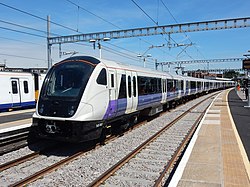Top Qs
Timeline
Chat
Perspective
TfL Rail
Two former commuter railway lines serving London, Essex, Berkshire and Buckinghamshire From Wikipedia, the free encyclopedia
Remove ads
TfL Rail was the concession which operated commuter services on two separate railway lines in London, England and its environs whilst the Crossrail construction project linking these lines was underway. It ran from 2015 until May 2022, upon the opening of the Crossrail central section, when TfL Rail was rebranded as Elizabeth line and the name was discontinued.[2][3][4]
TfL Rail was introduced on 31 May 2015 when it took control from Abellio Greater Anglia of the commuter "metro" service between London Liverpool Street in central London and Shenfield in Essex. The branch comprised the first 14 stations on the Great Eastern Main Line, with interchange at Shenfield for medium- and long-distance services beyond to East Anglia. TfL Rail had also taken over operation of some services from Paddington to Heathrow Airport and Reading. Services were operated by MTR Corporation under contract to Transport for London (TfL). Between May 2016 and May 2017, TfL Rail carried over 47 million passengers on the Shenfield branch.
Remove ads
History
Summarize
Perspective
In June 2013, TfL announced that Arriva, MTR Corporation, Keolis / Go-Ahead Group and National Express had been shortlisted to bid for the concession to operate Crossrail, which was under construction.[5][6]
In July 2014, TfL awarded the contract to Hong Kong's MTR, for a duration of eight years with an option to extend by an additional two years.[7][8]
MTR Corporation (Crossrail) was created as a new train operating company and took control of the "metro" service between London Liverpool Street and Shenfield from the previous operator, Abellio Greater Anglia, on 31 May 2015.[9] The existing Class 315 trains were re-painted in TfL Rail livery, and appropriate branding, advertising and message boards were added at the 14 stations along the line. Every station is staffed, from the first train to the last of the day. In June 2017, Class 345 trains began running between London Liverpool Street and Shenfield.[10]
In May 2018, TfL Rail took over operation of the Heathrow Connect service between London Paddington and Heathrow, as well as some GWR services between London Paddington and Hayes & Harlington.[11] In December 2019, TfL Rail took over operation of the Great Western Railway stopping services between London Paddington and Reading. In November 2019, Class 345 trains began running between London Paddington and Reading, as a soft launch of the service.[12][13] In July 2020, Class 345 trains began running between London Paddington and Heathrow.[14]
The two branches became part of the Elizabeth line when the central section opened on 24 May 2022, with the current branches connecting up with the core later.[15]
Remove ads
Route
The eastern branch of TfL Rail ran over the existing 20 miles 16 chains (32.5 km) of track on the Great Eastern Main Line between London Liverpool Street and Shenfield. The western branches operated over part of the Great Western Main Line and the Heathrow tunnel between London Paddington and Heathrow for 16 miles 38 chains (26.5 km), and entirely over the Great Western Main Line between London Paddington and Reading for 36 miles (58 km).
Stations
- Stations between Iver and Reading only accept contactless Pay-as-you-go and are therefore not in the Oyster zones
- Heathrow Terminal 5 was not officially served by TfL Rail, but services were diverted to this station when Heathrow Terminal 4 was closed during COVID-19
Remove ads
Former services
Summarize
Perspective
Shenfield branch

TfL Rail took over operations from Abellio Greater Anglia on 31 May 2015.[17] TfL Rail subsequently introduced a fleet of new Class 345 trains.[18][19] On 22 June 2017, Class 345 trains entered passenger service on the Shenfield branch.[20]
The Class 315 trains continued to be maintained at the existing Ilford depot, but the Class 345 trains are maintained at Old Oak Common and Ilford depots.
Heathrow branch
TfL Rail inherited five Class 360 units from Heathrow Connect when it took over operations on 20 May 2018. These trains were used to operate the existing half-hourly (2tph) service to Heathrow.[21] On 30 July 2020, Class 345 trains entered passenger service on the Heathrow branch.[14] The last Class 360 trains were withdrawn in September 2020.[22]
Reading branch
On 26 September 2019, TfL Rail announced that it would take over the Paddington to Reading stopping services on 15 December 2019,[23] using Class 345 trains in place of the Class 387 and Class 165 trains used by Great Western Railway. Before that, on 25 November 2019 six GWR services a day started to operate using Class 345 trains, operated by TfL, to get drivers ready and stock in place for the main 15 December switch over.[24]
Route tables
Prior to the opening of the Elizabeth line on 24 May 2022, the timetabled weekday off-peak service pattern consisted of:[25]
- During peak times, service frequency increased up to 4 trains per hour
- During the COVID-19 pandemic, Heathrow Terminal 4 station was closed, services diverted to Heathrow Terminal 5
Remove ads
Rolling stock
Fleet carried over to the Elizabeth line
Past fleet
Former units operated by TfL Rail include:
Remove ads
References
External links
Wikiwand - on
Seamless Wikipedia browsing. On steroids.
Remove ads








































